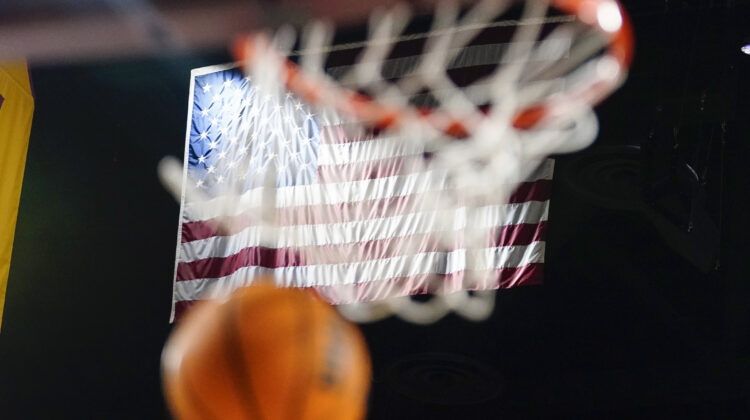In the dead of summer, nuclear winter is coming for a handful of Pac-12 schools excluded from the vicious realignment game.
USC, UCLA and Colorado have already given notice.
Oregon and Washington are leaving for the Big Ten.
Arizona, Arizona State and Utah are headed for the Big 12.
The remaining quartet — Stanford, Cal, Washington State and Oregon State — is facing a Defcon 1 scenario.
What are their options?
Can they maintain competitive football and basketball programs without the massive revenue that comes with membership in a top conference?
How will their Olympic sports and athletic department employees be impacted?
First, the schools have a morsel of time to spare. The Pac-12 will remain intact through the upcoming academic year, with all 12 schools competing.
More importantly, the money will keep flowing to each campus thanks to a media rights agreement with ESPN and Fox that remains intact until next summer.
But as the situation stands, the Pac-12 will be reduced to the Pac-4 at the start of the 2024 football season.
Because commissioner George Kliavkoff failed to finalize a media deal before the breakup of the conference, the remaining entity might not have the cash to fund operations. (Could bankruptcy be an option? Perhaps.)
There is also the not-insignificant matter of leadership.
Will Kliavkoff remain in charge through the upcoming sports season, or resign? An interim commissioner would need to be appointed to oversee operations and competition and find an escape hatch for the remaining schools.
Campus leadership is another issue for the remaining quartet. Cal chancellor Carol Christ is retiring next summer, Oregon State president Jayathi Murthy has been on the job for less than one year, and Stanford’s Marc Tessier-Lavigne is stepping down at the end of this month following an academic scandal.
Only Washington State’s Kirk Schulz, current chair of the Pac-12 board of directors, has the necessary tenure and grasp of college sports to provide strong leadership.
We see a handful of scenarios for the schools:
— Washington State and Oregon State join the Mountain West while Stanford and Cal compete as Independents.
— WSU, OSU and Cal join the Mountain West while Stanford alone goes the Independent route.
— The quartet sticks together and attempts to reform the Pac-12 through expansion, using a handful of Mountain West schools and perhaps SMU (from the American Conference) as the building blocks.
One of many challenges with this strategy is the timing: It’s unlikely the Pac-12 could add schools in time for the 2024 season because of logistical issues and exit fees in other conferences.
— The schools move en masse into the Mountain West, creating a 16-team mega-conference under the leadership of current commissioner Gloria Nevarez.
At that point, the next step would be the media rights piece. The MW’s current deal with Fox and CBS runs through 2026 and spins off an average of $4 million annually to each school.
Would the media partners agree to increase the payouts with the additions of four former Pac-12 members? That’s unclear. But any collection of Pac-12 and MW universities, regardless of the banner under which they compete, would provide potential media partners with either direct or peripheral access to seven of the top 40 markets in the country.
Market rankings nationally, according to Nielsen data from 2021:
6. Bay Area (Stanford, Cal, San Jose State)
16. Denver (Colorado State)
20. Sacramento-Modesto (Fresno State)
21. Portland (Oregon State)
27. San Diego (SDSU)
30. Salt Lake City (Utah State)
40. Las Vegas (UNLV)
Does that mean a lucrative media contract would be forthcoming? Nope. Not even close.
The remaining Pac-12 schools will receive a pittance of cash compared to what they stood to earn had the conference survived.
That dramatic drop in annual revenue will impact the budgets for every sport, from football on down, and potentially lead to layoffs and resource reductions on the four campuses.
Conferences have crumbled before, with the Big East as the best recent example.
After more than 40 years of existence, mostly as a basketball powerhouse, the league dissolved in 2013. The basketball-focused schools (dubbed the ‘Catholic 7’) left en masse, formed their own league — with the help of a media partner, Fox — and eventually purchased the name Big East from the schools that remained.
Meanwhile, the football-playing members of the dissolved league created the American Conference, which produced three schools (Houston, Cincinnati and UCF) that are now set to begin play in the Big 12.
Somewhere in that history, perhaps, is a model for the Pac-12 schools left behind in the realignment game.
*** Send suggestions, comments and tips (confidentiality guaranteed) to pac12hotline@bayareanewsgroup.com or call 408-920-5716
*** Follow me on Twitter: @WilnerHotline
*** Pac-12 Hotline is not endorsed or sponsored by the Pac-12 Conference, and the views expressed herein do not necessarily reflect the views of the Conference.
Related posts:

Washington State quarterback Cameron Ward (1) (AP Photo/Andy Manis)
Wilner Hotline – Saturday Night Five: Along come the Cougars, OSU’s big win, USC’s takeaways, collecting wins (except in Boulder) Hotline mailbag: Impact of UC regents’ delay, options for the Pac-12, ranking the coaches and why the football brands matter
Hotline mailbag: Impact of UC regents’ delay, options for the Pac-12, ranking the coaches and why the football brands matter  Wilner Hotline: Colorado hires Deion Sanders: A spectacular move by the Buffaloes, for better or worse
Wilner Hotline: Colorado hires Deion Sanders: A spectacular move by the Buffaloes, for better or worse  Hotline mailbag: Timing for media rights and expansion, SDSU vs. SMU, night kickoffs, CFP matters, the ‘Berkeley tax’ and more
Hotline mailbag: Timing for media rights and expansion, SDSU vs. SMU, night kickoffs, CFP matters, the ‘Berkeley tax’ and more
